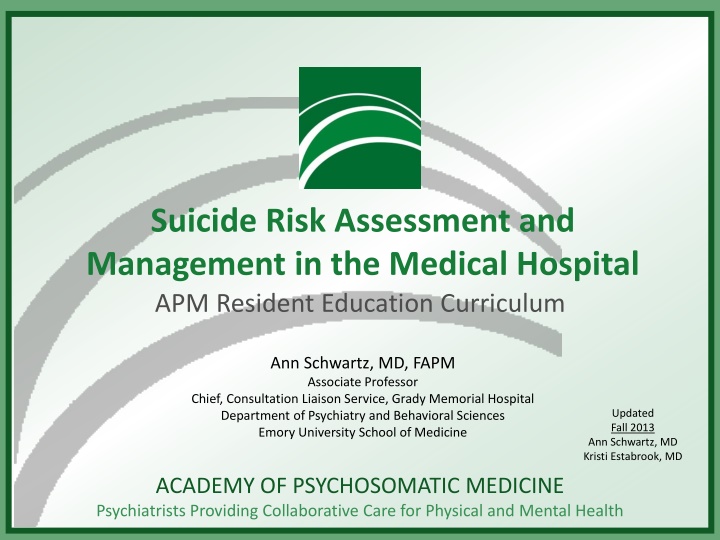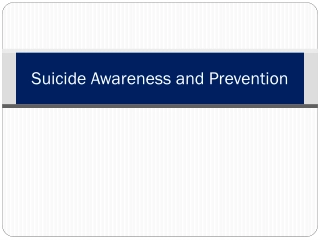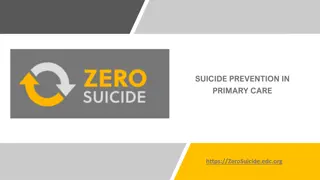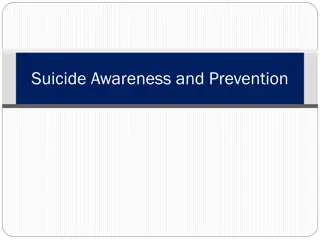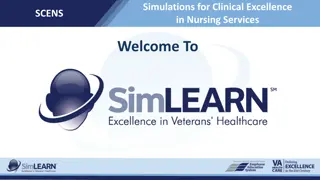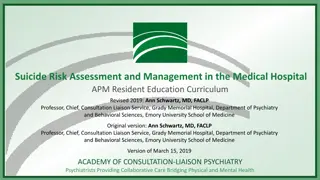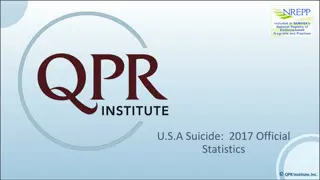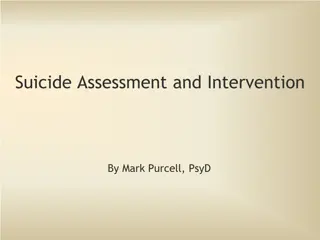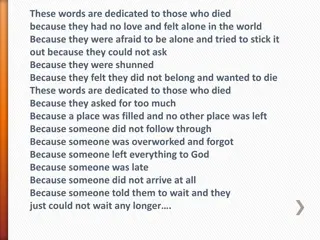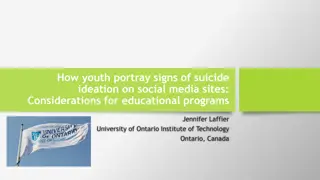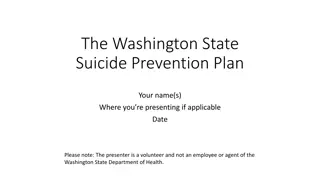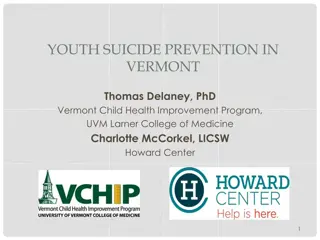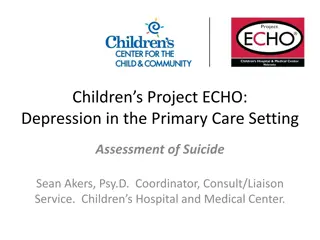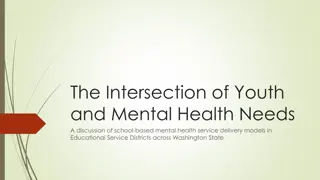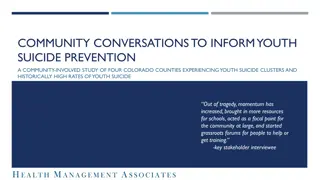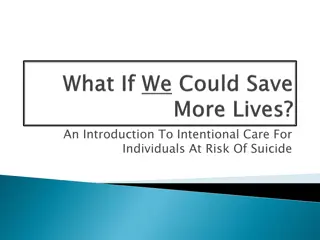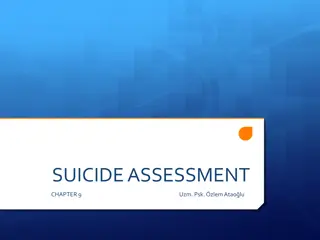Suicide Risk Assessment and Management Overview
This material provides a comprehensive overview of suicide, including definitions, epidemiology, and suicide-related behaviors. It covers the challenges in suicide risk assessment and documentation, highlighting the importance of accurately evaluating and managing suicide risk in medical settings. The content discusses the prevalence of suicide, common methods, and the intent behind suicidal behaviors. It emphasizes the need for proper assessment and intervention to prevent suicides and support individuals at risk.
Download Presentation

Please find below an Image/Link to download the presentation.
The content on the website is provided AS IS for your information and personal use only. It may not be sold, licensed, or shared on other websites without obtaining consent from the author.If you encounter any issues during the download, it is possible that the publisher has removed the file from their server.
You are allowed to download the files provided on this website for personal or commercial use, subject to the condition that they are used lawfully. All files are the property of their respective owners.
The content on the website is provided AS IS for your information and personal use only. It may not be sold, licensed, or shared on other websites without obtaining consent from the author.
E N D
Presentation Transcript
Suicide Risk Assessment and Management in the Medical Hospital APM Resident Education Curriculum Ann Schwartz, MD, FAPM Associate Professor Chief, Consultation Liaison Service, Grady Memorial Hospital Department of Psychiatry and Behavioral Sciences Emory University School of Medicine Updated Fall 2013 Ann Schwartz, MD Kristi Estabrook, MD ACADEMY OF PSYCHOSOMATIC MEDICINE Psychiatrists Providing Collaborative Care for Physical and Mental Health
Suicide Definitions Epidemiology Clinical assessment of suicide risk Suicide risk assessment / documentation Challenges 2 Academy Of Psychosomatic Medicine
Suicide The termination of an individual s life resulting directly or indirectly from a positive or negative act of the victim himself which he knows will produce this fatal result Durkheim 1857 3 Academy Of Psychosomatic Medicine
Epidemiology Suicide is the 11th leading cause of death in the US 30,000 deaths/year Accounts for 1 2% of all deaths Known suicide rate is nearly identical to rate in 1900 10-12/ 100,000/ year Firearms most common method (60- 65%) Regional variation Hanging second most common for men, drug overdose second most common for women For each person that completes suicide, ~8-10 people attempt For every completed suicide, ~18-20 attempts are made 4 Academy Of Psychosomatic Medicine
Suicide-Related Behaviors Potentially self injurious behaviors Suicide Instrumental suicide-related behaviors Focus on intent to die The person intended at some (non-zero) level to kill self . The person wished to use the appearance of intending to kill self in order to obtain some other end 5 Academy Of Psychosomatic Medicine
The person intended at some (non-zero) level to kill self . Suicide, completed suicide Suicide attempt with injuries Suicide attempt Suicidal act 6 Academy Of Psychosomatic Medicine
The person wished to use the appearance of intending to kill self in order to obtain some other end Parasuicidal acts Gestural Self-injurious Manipulative, dyadic, reactive, relational 7 Academy Of Psychosomatic Medicine
Suicide Intent Knowledge of lethality of method Cognitive capacity of victim Use of high lethality method Certain lethal vs. potential Planned, organized, persistent Multiple potential stopping points Active measures of non discovery/ prevention Active evasion vs. active discovery 8 Academy Of Psychosomatic Medicine
Case 1 HPI 38 yo AAF with hx of depression Admitted to medicine after overdose on sleeping agent Precipitant to attempt identified as feeling lonely 2-3 week hx of worsening depressive symptoms Daughter (3 yo) died ~5 years ago PAST PSYCH HX: 1 prior suicide attempt by OD after daughter s death 1 previous psych admission after OD PAST MEDICAL HX: HTN SOCIAL HX: Single, lives alone Many friends Has graduate degree and works as a banker Financial difficulties (bought car that she can t afford) Social ETOH, increased use recently Denies drug use FAMILY HX: Parents deceased Father with completed suicide when pt was 8 Mother died of CA when pt was 16 9 Academy Of Psychosomatic Medicine
Case 1 Mental Status Exam Thin, AAF who appeared her stated age Alert, cooperative, but tearful throughout interview Speech was normal rate, tone, and volume Mood was depressed, affect restricted but congruent with mood Thoughts were linear and focused on wanting to leave and return to work No overt delusions, denied AH/VH Denied current SI/HI Future-oriented behavior 10 Academy Of Psychosomatic Medicine
Case 1 Questions: Risk and protective factors for suicide? Modifiable Modifiable by treatment Non modifiable Risk factors potentially modified by inpatient psychiatric admission? Precautions while hospitalized medically? Disposition? Inpatient psychiatric admission Outpatient 11 Academy Of Psychosomatic Medicine
Suicide Assessment Through clinical evaluation, identify specific factors that may increase or decrease risk for suicide and suicidal behaviors that may serve as modifiable targets for interventions Address patients immediate safety and determine most appropriate setting for treatment Develop differential diagnosis to further guide planning of treatment 12 Academy Of Psychosomatic Medicine
Suicide Not a diagnosis Not limited to depression Schizophrenia Bipolar Substance use disorders Impulse control disorders Not limited to official psychiatric disorders States of desperation or despair Impulsive, aggressive, disinhibited 13 Academy Of Psychosomatic Medicine
Suicide Behavioral phenotype Low base-rate event Rare Hard to predict False positive Costly treatment decisions False negative Impact on family, practitioner and staff Legal liability 14 Academy Of Psychosomatic Medicine
Epidemiology ____________________________________________________________ Relationship between SI, attempts, and completed suicide 5.6% incidence of suicidal ideation per year U.S. population 0.7% incidence of suicide attempts per year 0.01% will complete suicide per year 15 Academy Of Psychosomatic Medicine
Risk Factors for Suicide Demographic Psychiatric Medical Social Familial Past and present suicidality Treatment settings Status as medical inpatient 16 Academy Of Psychosomatic Medicine
Non Modifiable Risk Factors Gender Male> female Race White> Non white minority Age Old> young Past behaviors Suicide attempts Family history complete suicide 17 Academy Of Psychosomatic Medicine
Modifiable Risk Factors Potentially modifiable Treatment Other process Mental status Current suicidal ideation Depression Anxiety Hopelessness/ despair Desperation Intoxication Access to high lethality means Firearm in home Recent loss / setback 18 Academy Of Psychosomatic Medicine
Psychiatric Risk Factors 90% with diagnosis Depression (MDE) common 30-60% with a substance use disorder Combination mood episode plus substance use disorder Most suicides with psych and substance diagnosis, but most psych and substance patients do NOT die from suicide 19 Academy Of Psychosomatic Medicine
Observable High Risk Agitated Anxious Psychomotor activity Emotional lability Global insomnia Appetitive disturbance Nihilistic distraction 20 Academy Of Psychosomatic Medicine
Observable High Risk High level distress Desperation Irritation Akathisia Mixed mania Anxiety Alcohol intoxicated 21 Academy Of Psychosomatic Medicine
Observable Low Risk Somnolent, sleepy, sleeping Calm Hungry, eating Self-directed actions I want Future directed actions Manipulative or dyadic If you don t ..I will kill myself 22 Academy Of Psychosomatic Medicine
Substance Abuse & Dependence Known risk factor for suicide Cocaine significant impact on mood EtOH intoxication Disinhibiting Chronic EtOH use Mood disorder 23 Academy Of Psychosomatic Medicine
Alcohol Use Preceding Suicide White > African American at all ages Gender follows race All age groups Average blood level above legal (0.08) definition of intoxication 24 Academy Of Psychosomatic Medicine
Medical Factors Medical illness, especially severe or chronic may be risk factor for completed suicide Modifiable vs. non modifiable Medical disorders associated with as many as 35-40% of suicides 25 Academy Of Psychosomatic Medicine
Medical Factors AIDS Cancer Head Trauma Epilepsy Multiple sclerosis Huntington s chorea Organic brain syndromes Spinal cord injuries Hypertension Cardiopulmonary disease Peptic ulcer disease Chronic renal failure Cushing s disease Rheumatoid arthritis Porphyria 26 Academy Of Psychosomatic Medicine
Social Risk Factors Marital status Social isolation Financial difficulties Recent loss / setback Unemployment Legal involvement Access to high lethality means Firearm in home Pharmaceutical products 27 Academy Of Psychosomatic Medicine
Socioeconomic Factors Macroeconomic forces impact suicide rates Employment Single parent households Housing availability Availability of psychiatric resources Lower SES might be associated with higher suicide risk 28 Academy Of Psychosomatic Medicine
Familial Factors Family history of suicide Family history of psychiatric illness Early parental death or separation History of emotional, physical, or sexual abuse 29 Academy Of Psychosomatic Medicine
Past and Present Suicidality Prior suicide attempts Non modifiable Suicidal ideation Potentially modifiable Suicidal intent Potentially modifiable Hopelessness Potentially modifiable 30 Academy Of Psychosomatic Medicine
Suicide Attempts Sensitive but NOT specific measure Non-modifiable risk factor ~10% of patients who make a medically serious suicide attempt ultimately die Identifies chronic high risk group Males at higher risk Unclear distinction between eventual completers and survivors Unclear impact of treatment 31 Academy Of Psychosomatic Medicine
Treatment Settings Status as medical inpatient increases suicide risk Paradox of psychiatric admission Major period of risk for completed suicide 2 weeks post discharge from psych unit Discharge leads to instability vs. admission identifies enriched high risk sample 32 Academy Of Psychosomatic Medicine
Protective Factors Potentially modifiable Treatment Other Restricted access to lethal means Skills in problem solving and conflict resolution Cultural and religious beliefs that discourage suicide Strong psychosocial supports Reasons for living Dependent children in home 33 Academy Of Psychosomatic Medicine
Case 2 47 yo WM with hx of HIV/AIDS and CHF Admitted to medicine with chest pain UDS, + cocaine Cardiac w/u essentially normal On discharge, pt verbalized SI Irritable on interview Endorsed irritability, insomnia, poor concentration, low energy Focused on finding place to stay and food No hx of mania or psychosis PAST PSYCH HX: 1 prior psychiatric admission for SI three years ago No prior suicide attempts PAST MEDICAL HX: HIV/AIDS CHF SOCIAL HX: Divorced, recently homeless 1 daughter (strained relationship) Unemployed, no income Cocaine use, amount unknown 34 Academy Of Psychosomatic Medicine
Case 2 Mental Status Exam Alert, disheveled, irritable, minimally cooperative Poor eye contact Speech was soft, normal rate Mood was irritable, affect reactive Thoughts were linear and focused on wanting housing and double portions No overt delusions + AH - telling me to kill myself, denied VH Endorsed SI, vague plan of smoking crack to blow up my heart Denied HI 35 Academy Of Psychosomatic Medicine
Case 2 Questions: Risk and protective factors for suicide? Modifiable Modifiable with treatment Non modifiable Risk factors potentially modified by inpatient psychiatric admission? What other information would be helpful in determining risk? Disposition? Inpatient psychiatric admission Outpatient 36 Academy Of Psychosomatic Medicine
What Distinguishes Those Who Commit Suicide From Those Who Do Not The risk states are very common Mental illness Substance use disorders Loss, illness, trauma etc The outcome is relatively rare in comparison to the at risk population Pathophysiological mechanism for rare event in common background Biology of suicide versus depression 37 Academy Of Psychosomatic Medicine
Suicide Risk Assessment Document formulation of individual risk and protective factors Document clinical reasoning and decision making Document interventions and follow up Risk factors modifiable with treatment Safety plan 38 Academy Of Psychosomatic Medicine
Suicide Risk Assessment (Risk Factors) Document static risk factors Document dynamic risk factors Psychiatric diagnosis Access to firearm Document mental status Expressed suicidal ideation Document Observable risk behaviors Agitation, anxiety, lability, etc 39 Academy Of Psychosomatic Medicine
Suicide Risk Assessment (Protective Factors) Document protective factors Gender, family structure Document low risk behaviors Somnolent, sleeping, future-directed, etc Document intent Parasuicidal, gestural, manipulative 40 Academy Of Psychosomatic Medicine
Suicide Risk Assessment Demographic characteristics impact risk Not modifiable Do impact decision making Highest risk White male Lowest risk African American female Age 45 and above (AAF) 41 Academy Of Psychosomatic Medicine
Suicide Risk Assessment Documentation Document presence of firearm in home Document discussion with patient/ family/ support group Remove weapon from home Safekeeping Minimizing access to high lethality means has been shown to reduce suicide rates 42 Academy Of Psychosomatic Medicine
Evaluation of Suicide Risk Nonjudgmental and supportive approach Evaluate suicidal ideation and intent Presence of suicidal thoughts Details of suicide plan Seriousness of intent (or attempt) Social supports Risk/rescue ratio Degree of impulsivity Assess for presence of risk factors Perform mental status exam Collateral information 43 Academy Of Psychosomatic Medicine
Management of Suicide Risk Stabilize medical conditions Safe containment Physical or chemical restraint Supervision (1:1 sitter) Remove dangerous objects Repeated observation / assessment Consider initiation of treatment 44 Academy Of Psychosomatic Medicine
Management of Suicide Risk Remove or treat modifiable risk factors Physical or chemical restraint Psychotherapy (supportive) Communication with consultant about treatment Psychiatric hospitalization Disposition Home with outpatient follow up Admission to medical unit Voluntary admission to inpt psychiatric unit Involuntary admission to inpt psychiatric unit 45 Academy Of Psychosomatic Medicine
In Hospital Prevention Treat agitation, anxiety and depression immediately and aggressively Communication with psychiatric and other treatment providers Inpatient Outpatient Encourage family support and involvement Encourage staff communication Treat pain aggressively Safety-proof patient rooms Trained 1:1 sitter 46 Academy Of Psychosomatic Medicine
Psychopharmacology and Suicide Decreasing suicide risk Use medications mainly to treat underlying mood disorders or acute distress Lithium and Clozapine have been show to decrease risk of suicide Possible increased risk? SSRIs in certain populations Black box warning for SSRIs in pediatric populations and ages 18- 24 This is controversial with conflicting evidence 47 Academy Of Psychosomatic Medicine
Challenges Intoxicated patients Threatening patients Uncooperative patients Countertransference issues 49 Academy Of Psychosomatic Medicine
Intoxicated Patients Current intoxication Hold till sober (BAL= 0.08) Reassess Substance use Proximate risk factor Treatment implications? Does chemical dependency treatment modify risk? 49 Academy Of Psychosomatic Medicine
Threatening or Uncooperative Patients Safety precautions Staff training Security Efforts to establish rapport Aggressive behavior is risk factor Move to safest area Crisis stabilization unit Law enforcement referral if indicated 49 Academy Of Psychosomatic Medicine
